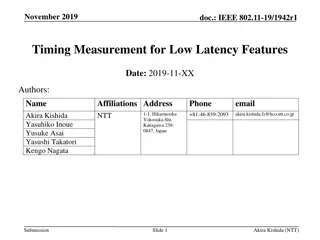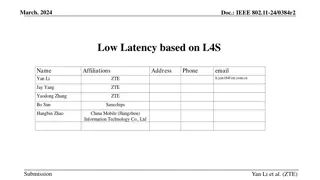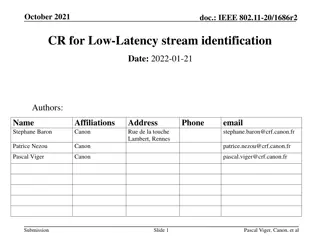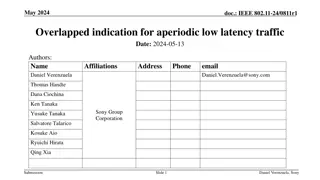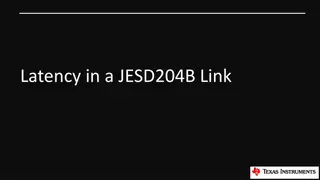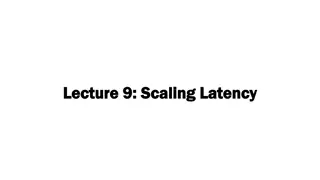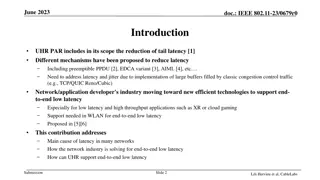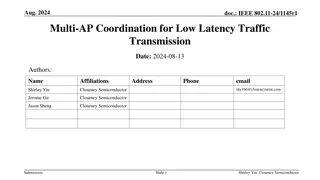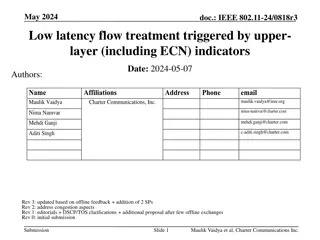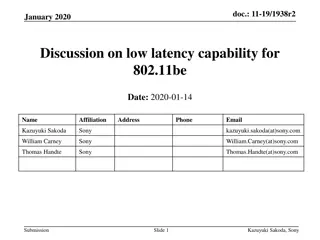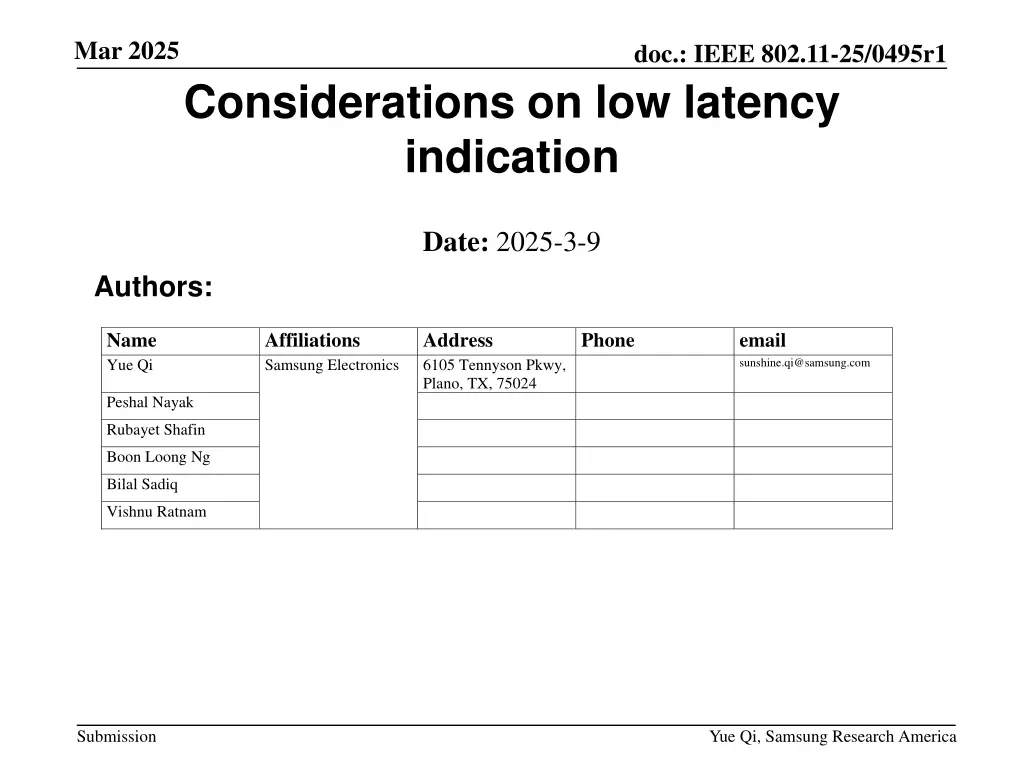
Enhancing Low Latency Indication in IEEE 802.11 Networks
Explore the challenges surrounding low latency indication (LLI) in IEEE 802.11 networks through a detailed analysis of current issues and proposed solutions. The document addresses concerns such as uncertainty in scheduling, lack of feedback mechanisms, and limitations in LLI negotiation. It also introduces a proposal for a more efficient LLI negotiation request and response framework, aiming to prioritize low latency traffic effectively across multiple Transmission Opportunity (TXOP) instances.
Download Presentation

Please find below an Image/Link to download the presentation.
The content on the website is provided AS IS for your information and personal use only. It may not be sold, licensed, or shared on other websites without obtaining consent from the author. If you encounter any issues during the download, it is possible that the publisher has removed the file from their server.
You are allowed to download the files provided on this website for personal or commercial use, subject to the condition that they are used lawfully. All files are the property of their respective owners.
The content on the website is provided AS IS for your information and personal use only. It may not be sold, licensed, or shared on other websites without obtaining consent from the author.
E N D
Presentation Transcript
Mar 2025 doc.: IEEE 802.11-25/0495r1 Considerations on low latency indication Date: 2025-3-9 Authors: Name Yue Qi Affiliations Samsung Electronics Address 6105 Tennyson Pkwy, Plano, TX, 75024 Phone email sunshine.qi@samsung.com Peshal Nayak Rubayet Shafin Boon Loong Ng Bilal Sadiq Vishnu Ratnam Submission Yue Qi, Samsung Research America
Mar 2025 doc.: IEEE 802.11-25/0495r1 Issues on the current LLI (1/2) After the TXOP responder indicating its low latency traffic, the TXOP holder should consider the indication in determining subsequent actions within the current TXOP or subsequent TXOPs. However, there is no way for the TXOP responder to know if the TXOP holder considers the indication or not. In addition, there is no way for the TXOP responder to know the actions from TXOP holder. 1) Uncertainty in scheduling. The TXOP responder has no visibility into how or when the TXOP initiator will schedule traffic based on its LLI. There is no assurance that the LLI will be honored or reflected in scheduling decisions during subsequent TXOPs. 2) Lack of feedback mechanism. The TXOP responder does not know whether the TXOP holder actually considered its low latency indication. This leads to a potential problem where LLT may not get prioritized as intended across multiple TXOPs. Submission Yue Qi, Samsung Research America
Mar 2025 doc.: IEEE 802.11-25/0495r1 Issues on the current LLI (2/2) Limitations of current LLI negotiation via SCS directly. 1) Ambiguity in LLI enablement when using SCS LLI is designed for handling urgent, un-predictable low latency traffic, often triggered spontaneously. In contrast, SCS assumes some detailed traffic is known and is enabled during explicit negotiation and acceptance. Therefore using SCS for LLI may cause ambiguity since it is unclear when and how LLI should be enabled if tied to SCS. This may lead to inefficient or unnecessary enablement of SCS where it does not match the application s behavior. 2) Risk of inefficient resource use with advance LLI enablement If LLI is enabled in advance (e.g., through SCS) but never used, system resources may be wasted. This is especially problematic for resource-constrained or high-density environments. 3) Inefficiencies in current LLI field usage within Control Infofield LLI parameters are included in the Control Info field, while many parameters like SCSID, TID, delay bound, or data rate may be difficult to determine ahead of time. As a result, many fields become either left unspecified or set to placeholder/default values (e.g., 0). E.g., although setting Minimum/Maximum Service Interval = 0 can be used to trigger LLI activation, resulting in suboptimal signaling efficiency. Submission Yue Qi, Samsung Research America
Mar 2025 doc.: IEEE 802.11-25/0495r1 Proposal: LLI negotiation request and response frame (1/2) Considerations: Reducing the frame overhead over full SCS where those unspecified fields can be removed. Repurposing the Control Info field and introducing actions that TXOP responder may request and the TXOP holder may response with, so that LL traffic can be reliably and consistently prioritized with improved response determinism across TXOPs. Enablement: the STA sends an LLI Setup Request frame to its associated AP. The AP may response with an LLI Setup response frame by accept or reject the request. Indication: During the LL session, an indication frame (e.g., Multi-STA BA) is transmitted such that AP may process the request within the current TXOP or subsequent TXOPs. The STAs may end the LL session (e.g., inactivity timeout, explicit teardown, etc.) Submission Yue Qi, Samsung Research America
Mar 2025 doc.: IEEE 802.11-25/0495r1 Proposal: LLI negotiation request and response frame (2/2) LLI Setup frames: Is designed to carry only minimal QoS-related indicators needed for LLI activation, minimizing unnecessary control overhead compared to full SCS QoS info. Variation of a QoS frames, repurposing and simplifying the Control Info field. LLI enablement may be positioned earlier before checking other fields such as TID, UP, and other info in the QoS Char. elements. Most of the fields that require the details of the LLT may be removed because the characteristics of the traffic maybe inherently unpredictable at the time of negotiation. Submission Yue Qi, Samsung Research America
Mar 2025 doc.: IEEE 802.11-25/0495r1 Proposal: LLI negotiation with Action Policy negotiation Motivation for Action Policy LLI requests alone may not be sufficient TXOP responder needs to indicate desired AP behavior. Current ambiguity in response handling (e.g., RDG vs. MU-RTS sharing) can delay or misalign LLI processing. Design options: Explicit Negotiation Semantics: Define how the AP should act when receiving LLI. Lightweight Signaling: Use minimal bits in Control Info to enable behavior differentiation, e.g., Action Policy field. Optional Field: Action Policy can be unset if response behavior is not required. Extendibility: Design allows future direction/action values for new traffic types (e.g., DL, P2P, multicast). Submission Yue Qi, Samsung Research America
Mar 2025 doc.: IEEE 802.11-25/0495r1 Proposal: LLI negotiation with Action Policy negotiation Encoding example: Action Policy = 0: TXOP responder requests TXOP sharing (e.g., MU-RTS TXS mode). Action Policy = 1: TXOP responder requests RDG support; AP should respond by setting RDG/More PPDU field. Direction Feedback Action policy TXOP responder s needs TXOP responder s request actions & TXOP holder s response actions 0 UL 1 Buffered low latency traffic. (existing) 0 TXOP sharing: TXOP responder requests MU- RTS TXS mode 1. 0 UL 1 Buffered low latency traffic. (existing) 1 RDG: grant RDG by setting RDG/More PPDU to 1. 1 DL 1 Buffered LLT when TXOP responder is AP. 0 TXOP sharing: TXOP responder requests TXOP sharing from the TXOP holder. Extendable 1 DL 1 Buffered LLT when TXOP responder is AP. 1 RDG: grant RDG by setting RDG/More PPDU to 1. 2 P2P 2 Request for P2P 0 TXOP sharing: TXOP responder requests MU- RTS TXS mode 2. 2 P2P 2 reserved 1 reserved Submission Yue Qi, Samsung Research America
Mar 2025 doc.: IEEE 802.11-25/0495r1 Conclusion The current LLI design lacks feedback and deterministic behavior across TXOPs. Design new lightweight signaling for LLI setup frames which may enable efficient targeted LLI negotiation with flexible Action Policies. The proposal introduces a negotiation framework that is scalable and low-overhead. Submission Yue Qi, Samsung Research America












